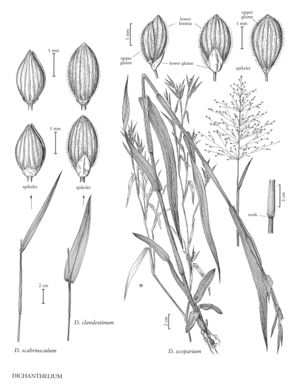Difference between revisions of "Dichanthelium scoparium"
FNA>Volume Importer |
imported>Volume Importer |
||
| (5 intermediate revisions by 2 users not shown) | |||
| Line 7: | Line 7: | ||
|synonyms={{Treatment/ID/Synonym | |synonyms={{Treatment/ID/Synonym | ||
|name=Panicum scoparium | |name=Panicum scoparium | ||
| − | |authority= | + | |authority= |
| + | |rank=species | ||
}} | }} | ||
|hierarchy=Poaceae;Poaceae subfam. Panicoideae;Poaceae tribe Paniceae;Dichanthelium;Dichanthelium sect. Clandestina;Dichanthelium scoparium | |hierarchy=Poaceae;Poaceae subfam. Panicoideae;Poaceae tribe Paniceae;Dichanthelium;Dichanthelium sect. Clandestina;Dichanthelium scoparium | ||
| Line 19: | Line 20: | ||
-->{{Treatment/Body | -->{{Treatment/Body | ||
| − | |distribution=Del.;D.C;Fla.;Puerto Rico;N.J.;Tex.;La.;Tenn.;N.C.;S.C.;Pa.;N.Y.;Va.;Md.;Ala.;Ark.;Ill.;Ga.;Ind.;Conn.;Kans.;Okla.;Mich.;R.I.;Mass.;Mo.;Miss.;Ky. | + | |distribution=Del.;D.C.;Fla.;Puerto Rico;N.J.;Tex.;La.;Tenn.;N.C.;S.C.;Pa.;N.Y.;Va.;Md.;Ala.;Ark.;Ill.;Ga.;Ind.;Conn.;Kans.;Okla.;Mich.;R.I.;Mass.;Mo.;Miss.;Ky. |
|discussion=<p><i>Dichanthelium scoparium</i> grows in moist, sandy, open, often disturbed areas of the southeastern United States. It is also present in the West Indies. The primary panicles are open-pollinated, produced from May to early August; the secondary panicles are cleistogamous and are produced from July through October.</p><!-- | |discussion=<p><i>Dichanthelium scoparium</i> grows in moist, sandy, open, often disturbed areas of the southeastern United States. It is also present in the West Indies. The primary panicles are open-pollinated, produced from May to early August; the secondary panicles are cleistogamous and are produced from July through October.</p><!-- | ||
--><p><i>Panicum</i> glutinoscabrum Fernald may represent rare putative hybrids of <i>Dichanthelium scoparium</i> with <i>D. acuminatum</i>, and P. mundum Fernald, rare hybrids with <i>D. dichotomum</i>.</p> | --><p><i>Panicum</i> glutinoscabrum Fernald may represent rare putative hybrids of <i>Dichanthelium scoparium</i> with <i>D. acuminatum</i>, and P. mundum Fernald, rare hybrids with <i>D. dichotomum</i>.</p> | ||
| Line 30: | Line 31: | ||
-->{{#Taxon: | -->{{#Taxon: | ||
name=Dichanthelium scoparium | name=Dichanthelium scoparium | ||
| − | |||
|authority=(Lam.) Gould | |authority=(Lam.) Gould | ||
|rank=species | |rank=species | ||
| Line 37: | Line 37: | ||
|basionyms= | |basionyms= | ||
|family=Poaceae | |family=Poaceae | ||
| − | |distribution=Del.;D.C;Fla.;Puerto Rico;N.J.;Tex.;La.;Tenn.;N.C.;S.C.;Pa.;N.Y.;Va.;Md.;Ala.;Ark.;Ill.;Ga.;Ind.;Conn.;Kans.;Okla.;Mich.;R.I.;Mass.;Mo.;Miss.;Ky. | + | |illustrator=Linda A. Vorobik;Hana Pazdírková |
| + | |illustration copyright=Utah State University | ||
| + | |distribution=Del.;D.C.;Fla.;Puerto Rico;N.J.;Tex.;La.;Tenn.;N.C.;S.C.;Pa.;N.Y.;Va.;Md.;Ala.;Ark.;Ill.;Ga.;Ind.;Conn.;Kans.;Okla.;Mich.;R.I.;Mass.;Mo.;Miss.;Ky. | ||
|reference=None | |reference=None | ||
|publication title= | |publication title= | ||
|publication year= | |publication year= | ||
|special status= | |special status= | ||
| − | |source xml=https:// | + | |source xml=https://bitbucket.org/aafc-mbb/fna-data-curation/src/200273ad09963decb8fc72550212de541d86569d/coarse_grained_fna_xml/V25/V25_1148.xml |
|subfamily=Poaceae subfam. Panicoideae | |subfamily=Poaceae subfam. Panicoideae | ||
|tribe=Poaceae tribe Paniceae | |tribe=Poaceae tribe Paniceae | ||
Latest revision as of 18:55, 11 May 2021
Plants in small clumps, with rhizomes 3-5 mm thick. Basal rosettes well-differentiated; blades sometimes more than 10 cm, lanceolate. Culms 50-150 cm, usually robust, erect; nodes often swollen, densely bearded with thin retrorse hairs above a constricted, glabrous, viscid ring; internodes grayish-purple, velvety-pubescent; fall phase branching from the mid- and upper culm nodes, with long, repeatedly forking and often recurving branches, ultimately with fascicles of reduced blades and included secondary panicles. Cauline leaves 7-11; sheaths not overlapping, narrowing distally, lustrous, bases sparsely to densely retrorsely villous, hairs papillose-based, summits purplish, with yellowish spots; collars densely villous; ligules 0.5-2 mm, of hairs; blades 9-20 cm long, 9-20 mm wide, thick, densely soft pubescent, bases rounded to subcordate, margins ciliate basally. Primary panicles 6-16 cm long, 5-12 cm wide, well-exserted, dense; rachises softly pubescent basally; branches often mottled with purplish viscid spots, glabrous. Spikelets 2.2-2.8 mm long, 1.3-1.5 mm wide, ovoid-ellipsoid, often purplish basally, prominently veined, margins and apices sparsely to densely pubescent, hairs papillose-based. Lower glumes 0.6-1.3 mm, subtruncate to acuminate; lower florets sterile; upper florets minutely apiculate. 2n = 18.
Distribution
Del., D.C., Fla., Puerto Rico, N.J., Tex., La., Tenn., N.C., S.C., Pa., N.Y., Va., Md., Ala., Ark., Ill., Ga., Ind., Conn., Kans., Okla., Mich., R.I., Mass., Mo., Miss., Ky.
Discussion
Dichanthelium scoparium grows in moist, sandy, open, often disturbed areas of the southeastern United States. It is also present in the West Indies. The primary panicles are open-pollinated, produced from May to early August; the secondary panicles are cleistogamous and are produced from July through October.
Panicum glutinoscabrum Fernald may represent rare putative hybrids of Dichanthelium scoparium with D. acuminatum, and P. mundum Fernald, rare hybrids with D. dichotomum.
Selected References
None.
